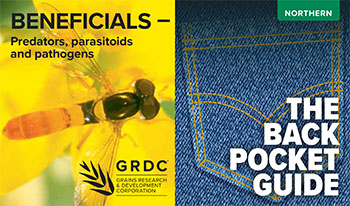Beneficials - Predators, parasitoids and pathogens (The Back Pocket Guide)
Published: 1 Jul 2018
Using this guide
Natural enemies
Beneficial organisms in agricultural systems include natural enemies, pollinators and nutrient cyclers. Natural enemies play an important role in suppressing populations of many key pest species in grain crops.
Being able to identify the suite of natural enemies that are active in your crops is the first step in integrating them into your management decisions. The preservation of natural enemies, through the judicious and selective use of insecticides, is central to harnessing the contribution that they make to suppressing pest populations and, consequently, minimising crop loss.
This guide provides a snapshot of key natural enemies of pests commonly encountered in grain crops in the northern region. The photographs and identification information are designed to assist growers to include natural enemies in their day to day crop monitoring.
This Back Pocket Guide contains the following Beneficials – predators, parasitoids and pathogens for the Northern Region:
- Wasp parasitoids of caterpillars – solitary
- Wasp parasitoids of caterpillars
- Wasp parasitoids of eggs – caterpillars and bugs
- Wasp parasitoids of whitefly (greenhouse and silverleaf)
- Wasp parasitoids of aphids
- Wasp parasitoids of soybean stemfly
- Fly parasitoids
- Predatory bugs – large
- Predatory bugs – small to medium
- Predatory beetles – ladybirds (large)
- Predatory beetles – ladybirds (small)
- Predatory beetles
- Lacewings
- Hoverflies
- Spiders
- Ants
- Predatory (native) earwigs
- Pathogens – bacteria and viruses
- Pathogens - fungi
Download PDF
Region: North
Was this page helpful?
YOUR FEEDBACK

